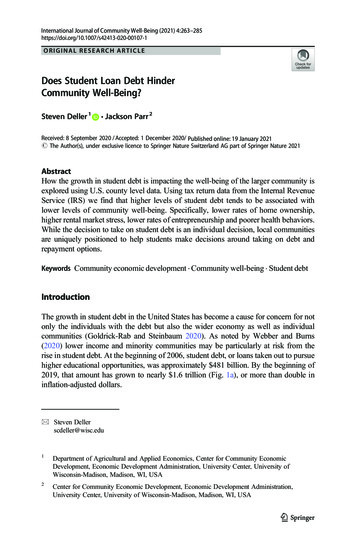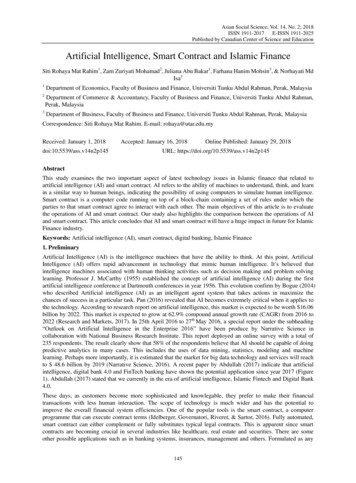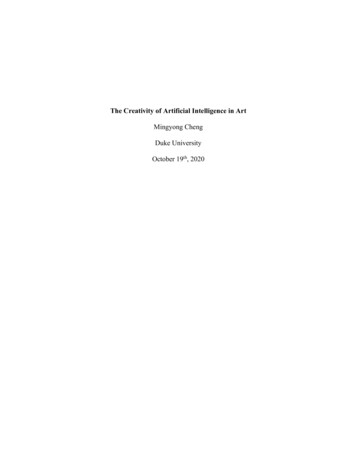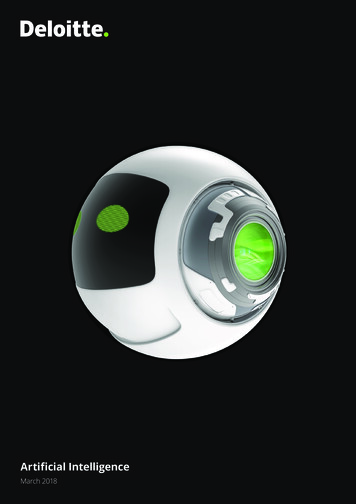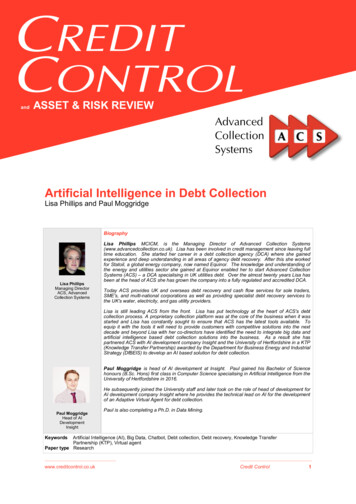
Transcription
andASSET & RISK REVIEWArtificial Intelligence in Debt CollectionLisa Phillips and Paul MoggridgeBiographyLisa PhillipsManaging DirectorACS, AdvancedCollection SystemsLisa Phillips MCICM, is the Managing Director of Advanced Collection Systems(www.advancedcollection.co.uk). Lisa has been involved in credit management since leaving fulltime education. She started her career in a debt collection agency (DCA) where she gainedexperience and deep understanding in all areas of agency debt recovery. After this she workedfor Statoil, a global energy company, now named Equinor. The knowledge and understanding ofthe energy and utilities sector she gained at Equinor enabled her to start Advanced CollectionSystems (ACS) – a DCA specialising in UK utilities debt. Over the almost twenty years Lisa hasbeen at the head of ACS she has grown the company into a fully regulated and accredited DCA.Today ACS provides UK and overseas debt recovery and cash flow services for sole traders,SME's, and multi-national corporations as well as providing specialist debt recovery services tothe UK's water, electricity, and gas utility providers.Lisa is still leading ACS from the front. Lisa has put technology at the heart of ACS's debtcollection process. A proprietary collection platform was at the core of the business when it wasstarted and Lisa has constantly sought to ensure that ACS has the latest tools available. Toequip it with the tools it will need to provide customers with competitive solutions into the nextdecade and beyond Lisa with her co-directors have identified the need to integrate big data andartificial intelligence based debt collection solutions into the business. As a result she haspartnered ACS with AI development company Insight and the University of Hertfordshire in a KTP(Knowledge Transfer Partnership) awarded by the Department for Business Energy and IndustrialStrategy (DfBEIS) to develop an AI based solution for debt collection.Paul Moggridge is head of AI development at Insight. Paul gained his Bachelor of Sciencehonours (B.Sc. Hons) first class in Computer Science specialising in Artificial Intelligence from theUniversity of Hertfordshire in 2016.He subsequently joined the University staff and later took on the role of head of development forAI development company Insight where he provides the technical lead on AI for the developmentof an Adaptive Virtual Agent for debt collection.Paul MoggridgeHead of AIDevelopmentInsightPaul is also completing a Ph.D. in Data Mining.KeywordsArtificial Intelligence (AI), Big Data, Chatbot, Debt collection, Debt recovery, Knowledge TransferPartnership (KTP), Virtual agentPaper type Researchwww.creditcontrol.co.ukCredit Control1
Artificial Intelligence in Debt CollectionAbstractArtificial Intelligence is making its way into all parts of our business and privatelives. The debt collection sector is no exception. Advances in AI technologiesmean that it is now possible to build a virtual agent that can take on a real-timecustomer facing role in debt recovery and autonomously negotiate debt repayment.Armed with the virtual agent a company will be able to reduce its overhead costs,improve collection rates, and provide a 24/7 service. In this article Lisa Phillips, MDof ACS, and Paul Moggridge from AI development company Insight provide aframework in which these developments can be understood, describe what isneeded from a debt collection virtual agent, present the status of development ofsuch an agent, and enumerate the benefits a virtual agent will bring to a business.IntroductionArtificial Intelligence and its abbreviation AI are the buzz words of today.Companies use them to explain what they do and to make solutions and productssound smarter and more sophisticated than they are. AI is a broad and complexsubject. In the broadest sense AI can be described as building computers androbots to do human tasks which we consider require intelligence such as to buildhuman like machines, to collect data, and to analyse data. The consequence isthat AI can be used to describe almost anything. However, the overuse of theterms makes it near impossible for the layman to separate what is a true AI basedsolution from what is hyperbole.In the world of debt collection the techniques used to gather and process “big data”to classify debtors and recommend actions regularly use AI and machine learningtechnologies. These solutions are established and growing. They are back officesolutions used by credit management departments and Debt Collection Agencies(DCAs) to enhance productivity or support business growth.An emerging application of AI in this sector is to build virtual agents for debtcollection. Virtual agents are customer facing and are already being deployed inother sectors. The growth in their sophistication is likely to result in solutions moresimilar to the popular concept of an artificial intelligent system seen in the moviesthan will the back office AI solutions.One of the programmes for developing a virtual agent for debt collection is the workfunded by the Department for Business, Energy & Industrial Strategy through itsKnowledge Transfer Partnerships (KTP)1 programme and carried out by apartnership of AI development company Insight, the University of Hertfordshire anddebt collection agency, ACS2. The aim is to build an AI enabled solution tonegotiate debt repayments.The purpose of this paper is to discuss AI in debt collection. It provides an overviewof AI and looks at chatbots and their relevance to AI in debt collection. It alsodescribes the work being carried out to build a virtual agent for debt collection, andreviews the benefits of the virtual agent to the debt collection process and business.2Credit Controlwww.creditcontrol.co.uk
Artificial Intelligence in Debt CollectionWhat is Artificial Intelligence (AI)AI is the application and merging of many different sciences. These includemathematics, statistics, machine learning, data mining, programming, philosophy,psychology, control theory, computer engineering, and bio-computation – the list isalmost endless.Artificial intelligence engenders a range of views as to its efficacy and safety:Steven Hawkins backing both horses commented “(AI) could either be thebest or the worst thing for the human race.”Elon Musk is more partisan and believes “AI is our biggest existential threat.”Whilst Huw Price, Professor of Philosophy at the University of Cambridgesaid, “the potential benefits of creating intelligence is huge” and it will“transform every aspect of our lives.” and Sundai Pichar, Google’s CEO, called it “one of the most importantthings humanity’s working on. It’s more profound than electricity or fire.”Artificial intelligence is jargon heavy and multifaceted but in general all AI solutionscan be described as belonging to one of two types General and Specialised.1.General AI: These are learning systems and all round performers. Systemswhich fall into this category are synonymous with the AI of popular culture –that is the C3P0, R2-D2, and iRobot AI incarnations. There are few if no truegeneral systems around today.2.Specialised AI: These are the workhorses of AI. They are designed toperform specific tasks and be very good at those tasks. This type of AIsystem is commonplace. Some of the applications which use a specialised AIinclude smart phones, smart homes, and robot vacuum cleaners. Otherapplications which use AI but its use is not obvious are Duolingo and Netflix.Figure 1: The Four Types of AIwww.creditcontrol.co.ukCredit Control3
Artificial Intelligence in Debt CollectionHow to understand AI and its capabilitiesUnderstanding how AI can help us in our jobs means having an appreciation of thetypes of AI that are available, the nature and benefit of the AI solutions which canbe built with these, and how they may be combined to create a powerful tool.A practical tool for thinking about AI and explaining its capabilities are thedefinitions proposed by Russel and Novig in their seminal book Artificial intelligencea modern approach3. This has become the de facto encyclopedia of all things AIand one of the most popular books in the field.Russel and Novig proposed that AI systems could be described by how they weredesigned to achieve their function. They proposed that solutions which used AI toachieve a function did so by either thinking humanly, acting humanly, thinkingrationally, or acting rationally.Figure 2: Comparing AI solutionsIn practice AI based solutions show a combination of these characteristics in theirdesign. This is illustrated by comparing three AI applications Deep Blue, AmazonAlexa and NatWest Cora. Each exhibits a different combination of thesecharacteristics: 4Deep Blue: One of the earliest examples of AI was IBM’s Deep Blue.Designed to play chess Deep Blue worked by exploring every possible moveand always choosing the action with the most possible win scenarios. It wasCredit Controlwww.creditcontrol.co.uk
Artificial Intelligence in Debt Collectionprimarily designed to act and think rationally. It did not think in a human wayand did not act in a human way. Deep Blue used a brute force approach, andone of its developers even disclaimed that it was artificial intelligence at all. Amazon Alexa: Amazon Alexa produces an illusion of being a human andacts somewhat humanly. It performs certain tasks well in a human fashion butbehind the scene pre-programmed functions are being called to achieve a lotof the functionality. Amazon Alexa relies primarily on acting rationally andthinking rationally. NatWest Cora4: A solution believed to use AI which thinks like a human andacts like a human is the virtual reality chatbot Cora. Developed by SoulMachines5 for UK bank NatWest this system acts very humanly and modelsthe way humans think, simulating aspects of the human brain. The bank hasused Cora since 2017. The new Cora prototype draws upon advances inneuroscience, psychology, computing power and artificial intelligence. It is ahighly life-like digital human that customers can have a two-way verbalconversation with on a computer screen, tablet or mobile phone.Chatbots – what are they and why are they importantA chatbot is a computer program which conducts a conversation via text or voiceinteractions. Typically a user asks a chatbot a question or gives it a command, andthe chatbot responds or performs the requested action. In business they are usedto deliver customer service or for information acquisition. These are the automatedself-service portals we encounter every day.Chatbots vary in their sophistication. Some use sophisticated natural languageprocessing (NLP) systems. Simple chatbots scan for keywords, then give a replywith the most matching keywords, or the most similar wording pattern.Virtual agents: When combined with AI chatbots can be made into powerful virtualagents. Virtual agents vary in their sophistication. Some are capable of completingcomplex tasks and exhibit human like interaction. Cora is an example ofsophisticated AI used in a chatbot.Examples of virtual agent (VA) solutions we encounter every day, with arguably aless sophisticated AI than Cora, are Google Assistant, Siri, Cortana and Alexa.Although many of these “people facing” virtual agent solutions seemingly act in ahuman way they are like Amazon Alexa in that they give the appearance of beinghuman but think and act rationally.Conversation via text or voice interactions: In some applications virtual agentswhich conduct a conversation via text offer greater flexibility for communication thanthose which rely on speech. Virtual agents which use text can show information,offer selectable options as well as holding a text based conversation with thecustomer. Hewlett Packard have used this versatility to build its “Virtual Assistant”which will help you select the correct supplies for your printer in much the same wayas a human assistant.www.creditcontrol.co.ukCredit Control5
Artificial Intelligence in Debt CollectionAI and Virtual Agents for debt collectionNon-interactive non-real-time AI applications: AI based solutions are alreadybeing used in debt collection. Typically these are back office non-real timesolutions used by credit management departments and DCAs to enhanceproductivity or support business.Figure 3: Applications for AI in businessResearch by TechEmergence, a business providing market research andcompetitive intelligence for the business applications of artificial intelligence,suggested that the most disruptive AI applications in debt collection were thoseused to analyse large amounts of historical records (typically held by the banks andother financial institutions). The AI applications were used for driving messagingcampaigns, personalising customer (debtor) service, and debt management. Themost significant usage trend discovered by TechEmergence was for thepersonalisation of customer communications. It found that the personalisation ofcommunications had resulted in some increase in repayment rates.In its report TechEmergence suggested that because the effectiveness of these AIsolutions depended on having access to a large pool of customer histories or alarge amount of current data, small to medium sized businesses might not havesufficient scale to successful deploy an AI solution.Interactive real-time AI applications: Advances in AI mean that it is now possibleto build a virtual agent which is able to interact with a human and autonomouslynegotiate debt repayment. This is not an impossible dream. Work is already welladvanced in this area.6Credit Controlwww.creditcontrol.co.uk
Artificial Intelligence in Debt CollectionWithin the next year the next step forward for AI in debt collection will be a virtualagent with human characteristics which amongst other things can detectvulnerability and negotiate repayment autonomously. This virtual agent will begeneration beyond the AI based chatbots found on websites today. It will havehuman like emotions and characteristics and take a frontline role in collecting andnegotiating debt repayments.The human characteristics needed: Virtual agents for debt collection must beable to act and think like a human agent. This requires a sophisticated AI. Theability to detect lying, detect vulnerability and plan negotiation strategy are complexhuman traits. To be an excellent negotiator and handle the sensitivities of the debtconversation the AI used by virtual agents needs to have both a fixed rationalsystem and the capacity to use emotions. These virtual agents like their humanrole models will need to be capable of: Perception: Good collection agents need the perception to enable them toconstruct a perceived model of the individual customer, to understand theirmind set, and to form a view about their vulnerability and willingness to pay. Adaptability: Agents need to adapt their tone and style throughout a debtnegotiation and when dealing with different customer types and debt. Detecting human emotions: Agents need to be able to detect humanemotions using hidden cues such as word usage or other inputs such as theway someone is speaking or, in the case of a virtual agent conducting aconversation via text, in the way they are typing. Learning and optimising: Agents need the ability to learn the behaviours andpreference of debtors from experience such that they can draw on theseexperiences and negotiate the best possible outcome.This means that a virtual agent for debt collection must not only think and actrationally but also think and act humanly.AI designed for debt collection:To give the virtual agent the humancharacteristics it needs for debt collection has meant that the developmentprogramme has needed to build from the ground up. The result is a highlysophisticated virtual agent solution dedicated to debt collection with the ability tothink and act like a human as well as thinking and acting rationally.The debt collection virtual agent, like its human role model, needs to be capable ofdetecting lying, detecting vulnerability and planning negotiation strategy. Toachieve this, cutting edge research has been carried out by the University ofHertfordshire in disciplines spanning computer science and psychology such as: Negotiation patterns: The psychology team at the university has carried outresearch with ACS to analyse the negotiation patterns of human debtcollection agents.www.creditcontrol.co.ukCredit Control7
Artificial Intelligence in Debt Collection Web page lying: Research by the psychology team into lying during real timedata entry on a web page has revealed ways to identify answers andinformation which could need reconfirming. Wealth indicators: Methods for using publicly available information to revealthe clues and indicators of the customer’s ability to pay have been researchedby the computer science team at the university. Data mining of voice based debt negotiations: The computer science teamat the university has worked with ACS to develop methods to data mine thevoice negotiations of debt collection agents and harvest the hiddeninformation.Figure 4: Cutting edge researchNovel communication: To enable the virtual agent to lead an intelligentconversation with the customer and negotiate repayment has necessitated arethinking of the way the virtual agent will communicate with the customer.The text and voice based communications typically used by AI chatbots are notsuited to debt collection virtual agents. As a result a forms based communicationhas needed to be developed by the team. The forms based agent will reducestress for the customer and offers several advantages over the other types ofcommunications: 8Flexibility: The forms based virtual agent offer greater flexibility forcommunication than speech based virtual agents. The forms based virtualCredit Controlwww.creditcontrol.co.uk
Artificial Intelligence in Debt Collectionagent can show information, offer selectable options as well as holding aconversation with the customer. Reliability: Speech based agents suffer from unreliable speech recognition innoisy environments or when the language becomes even slightly complex.They are often time consuming to use as they require you to structure yourresponse to the virtual agent. Sometimes it can take several attempts for thevirtual agent to understand the response.Privacy: Speech based virtual agents do not provide the same level of privacythat a text or forms based agent does. This can lead to a feeling of stress forthe customer. Text based agents can be used discretely. There is no spokenconversation which can be overheard by others. Time: During a negotiation the customer often wants time to think andconsider before replying. The timeouts built into voice based agents are asource of unwanted pressure for the customer as they are required to make aresponse within the timeout or are asked the question again. Text of formsbased agents are able to deal with pauses for thought. The customer enterstheir response when they are ready and able. More acceptable: People are often unsettled when Avatars and audio/visualsimulations closely resembling humans in many respects but not quiteconvincingly realistic are used. This is known as the uncanny valleyhypothesis6.The value and role of Virtual Agents in debt collectionA human agent in all but name: The aim of the work funded by the DfBEISthrough its Innovate UK programme is to build an AI enabled solution to negotiatedebt repayments. The virtual agent will be a generation beyond the chatbots foundon websites today. It will take a frontline role in collecting and negotiating debtrepayments.The debt collection virtual agent is a game changer for the sector. It will benefit thecompany, the process of debt recovery, and the customer. For instance, managersat all levels within a business will see it either as a strategic business asset or apowerful operational resource.Company directors: Companies will be able to manage higher debt volumes withexisting staffing levels and have more flexibility when planning budgets. For DCAsit will impact the firm’s ability to compete in marginal markets, lower the cost of entryto new debt markets, control overhead costs, and offer customers a 24/7 service.Its impact will be felt on: Growth: Growth will be possible without the need to increase physicalheadcount. Profit: The efficiency of debt collected can be improved and profit per agentincreased.www.creditcontrol.co.ukCredit Control9
Artificial Intelligence in Debt Collection Business intelligence: The ability to pre-empt default via better customerinsight/intelligence can be increased. Customer care: The customer journey and care can be enhanced by betterprofiling and identification of the customer type, appropriate handling andcommunications, and providing a personalised 24/7 experience. Credit Managers: For credit managers managing busy departments, thevirtual agent will be a powerful operational resource giving them additionalstaff resources and control. It will provide: Flexible staff resource: The virtual agent can be turned on and turned off asneeded and with the ability to autonomously negotiate repayments thedepartment’s headcount can be matched to the volume of work on a dailybasis. Consistent performance: The quality of the virtual agent’s decision-makingand negotiation skills remain constant. Skills versatility: With the ability to select the character and sector and debtexperience of the virtual agent the collection team can be supported withspecific skills as and when required. Accountability:Subjectivity is removed from the collection process.Decisions can be explained and rationalised. An audit trail of decisions made,documents presented, and negotiations concluded is an inherent feature ofthe virtual agent. This will assist in responding to any regulation andcompliance complaint received. Affordability: The virtual agent is envisaged to be a marginal cost for acollection department thus making it economic to collect low value debt. Thevirtual agent can be turned on and off as required meaning there is no ongoing permananet staffing cost to consider.Recovery rates and debt collection: Anecdotal evidence from the researchcarried out by TechEmergence suggests that using AI solutions for personalisationof messaging can result in an increase in repayment rates. The real time AI in theform of the virtual agents being developed by the Innovate programme has thepotential to deliver even greater benefits for the debt collection process including: Better outcomes: There is never a time when the virtual agent will suffer fromtiredness or be unduly affected by aggressive customers. Personality suited to the customer: The personality and mood of the virtualagent can be adjusted to match the target customer type. This will aidestablishing good communications and rapport and empathy. Detection of vulnerable debtors: With techniques built in to detectvulnerable customers the virtual agent will know when and when not tocompromise.10Credit Controlwww.creditcontrol.co.uk
Artificial Intelligence in Debt Collection Handle complex debts: Like a human collector the virtual agent will learnfrom its experience, and as its learning progresses take on more complexnegotiations.Scalability: The virtual agent offers unlimited scalability. High volumes ofdebt can be managed simultaneously.Compliance: The ability to build in an understanding of compliance rulesmean that all negotiations managed by the virtual agent will be compliant withcurrent regulations.Figure 5: Corporate benefits of AIThe future has arrivedThe Innovate UK programme is a three year funded programme. The programmeis two years in and the first prototype of the virtual agent is soon to be available.This will be trialed in early 2019. Once the trial is complete a beta version will beplaced by Insight in credit management departments of selected companies.This article first appeared in Credit Control Journal and Asset & Risk Review Volume 40 Number 2 2019Published by:House of Words Media Limited7 Greding Walk, Hutton, Brentwood, Essex, CM13 2UF UKWebsite: www.creditcontrol.co.uk 2019 House of Words Media Limitedwww.creditcontrol.co.ukCredit Control11
The purpose of this paper is to discuss AI in debt collection. It provides an overview of AI and looks at chatbots and their relevance to AI in debt collection. It also describes the work being carried out to build a virtual agent for debt collection, and reviews the benefits of the virtual agent to the debt collection process and business.


